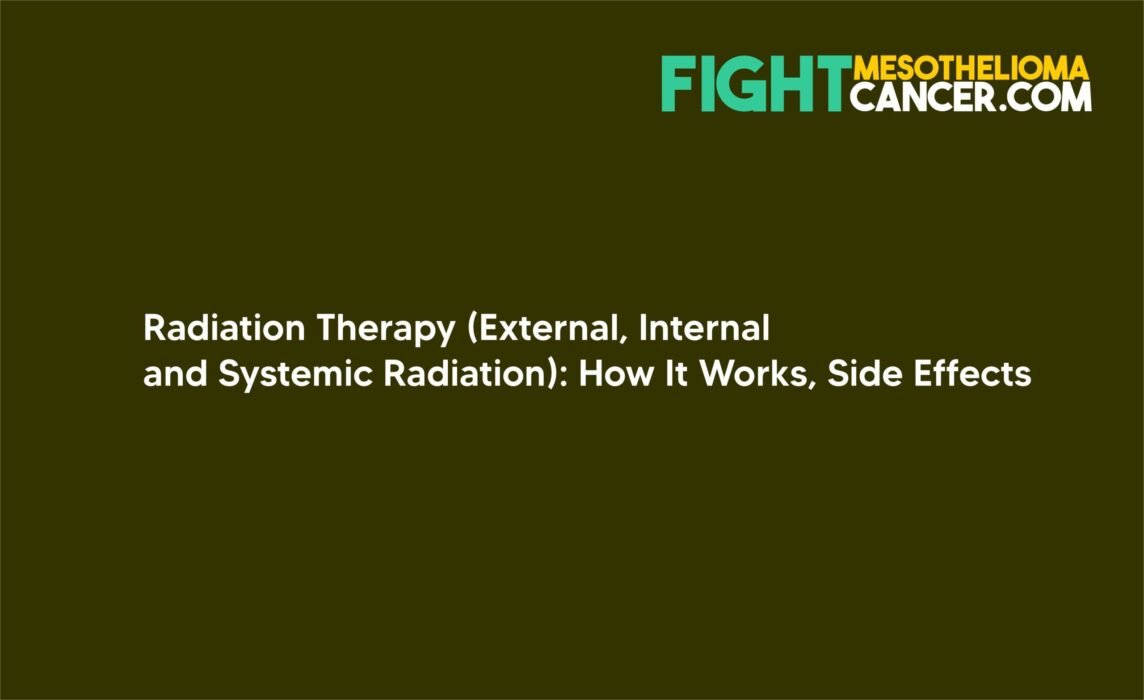Radiation therapy or Radiotherapy is the use of ionizing radiation to kill or control the growth of malignant or cancerous cells.
Radiotherapy is used as a palliative treatment option for patients suffering from mesothelioma lung cancer because no definite cure is available for this disease.
The basic theory behind radiotherapy is that it uses energy waves or particles to destroy cancer cells & tumor masses.
In other cases, radiotherapy is used to prevent future tumor cells from growing; where no present cancer cells can be found. There are 3 types of radiation therapy; external, internal, and systemic and each of them is discussed below.
Radiotherapy is usually confused with radiology which is the use of radiation in medical imaging techniques; they are two different things.
Before conducting a radiotherapy campaign on a patient, doctors have to determine the type of tumor they are trying to kill, location and what stage it has developed to.
Overall well being of the patient & previous side effects is also taken into account.
How Radiation Therapy Works
Radiation therapy functions by destroying the DNA of cancer cells. The destruction is caused by an electron beam that ionizes the atoms that reside in the DNA chain both directly and indirectly.
Ionizing in this context is the process of converting atoms or molecules that reside in cancer cells into ions by adding/subtracting charged particles such as other electrons and ions.
Indirect ionization occurs when radiation therapy forms water as a result of ionization, which then forms free radicals that damage the DNA of cancer cells. Because Cancer cells are stem-like and undifferentiated, they tend to reproduce more and faster.
Cell division forces damage to the DNAs of these cells, forcing them to die and not be able to reproduce. For example, Proton radiotherapy works by sending protons with varying kinetic energy to directly kill the tumors.
One of the disadvantages of using radiotherapy is that cells that contain solid tumor masses become deficient in oxygen.
This low-oxygen condition is known as ‘hypoxia’ and when hypoxia occurs, tumor masses are more resistant to the effects of radiotherapy due to lack of oxygen.
The role of oxygen in this process is so important that it is oxygen that makes DNA damage to cancer cells permanent.
Types of Radiation Therapy
1. External Radiation
External radiation is conducted by a two-dimensional beam outside of the body that uses linear accelerator machines delivered to the patient in several different angles.
The beam resides on a calibrated diagnostic x-ray machine (also known as a ‘simulator’). The simulator aims to target cells that contain tumor masses and kill these cells via the beam.
The specific beams that are used to kill lung cancerous cells are called ‘Megavoltage X-rays.’ This beam may also be given after surgery to reduce the chance of solid tumor masses from forming again.
2. Internal Radiation or Brachytherapy
Brachytherapy is also known as the ‘sealed source radiotherapy’ where a radioactive material is placed next to solid tumor masses that are waiting to be destroyed.
This radioactive material is placed in a small tube, capsule or a seed. For instance electronic brachytherapy places a miniature low energy (<50kVp) x-ray tube into a position nearby the tumor masses to rapidly deliver high doses of targeted cancerous tissues and destroy them, while maintaining low doses to non-cancerous nearby tissues.
The image above is of Seeds (small radioactive rods) that are placed directly near the tumor masses in the abdomen or in the lungs.
Common side effects of Brachytherapy include becoming infertile & impotent. Infact, between 6% to 50% of patients who have received Brachytherapy have reported becoming impotent. It is due to this reason that internal radiation is not commonly used.
3. Systemic Radiation (Intensity-Modulated Radiation Therapy (IMRT))
Intensity-Modulated Radiation Therapy (IMRT) is a fairly new & sophisticated type of radiation therapy where Computer-controlled x-ray accelerators spread precise radiation doses to malignant tumor masses.
The pattern of how radiation is delivered is determined using highly-tailored computing applications to perform optimization and treatment simulation. The dose of radiation is made same as the 3-D shape of the tumor by modifying the radiation beam’s intensity.
The dose of radiation is increased near solid tumor masses while it is decreased near non-malignant tissues. This customized form of radiation is done to ensure the malignant tissues get destroyed while preserving the nearby non-malignant & healthy tissues.
Because the doses of radiation are modified according to how tumorous the tissues are, this type of radiotherapy is better than the conventional type & results in better tumor targeting, less side effects and improved treatment results.
dr. Bulawan

